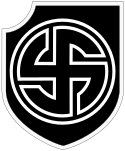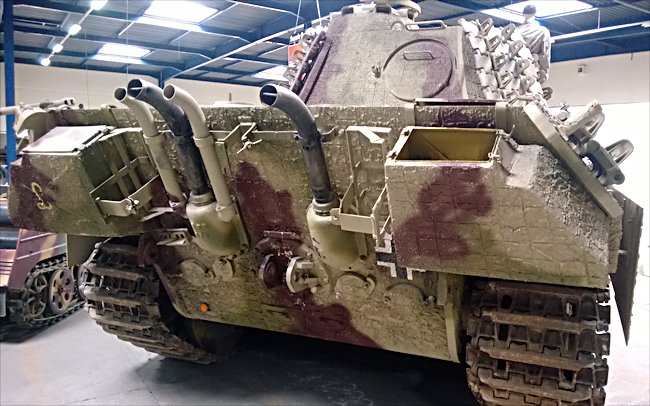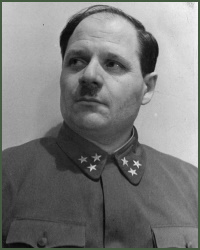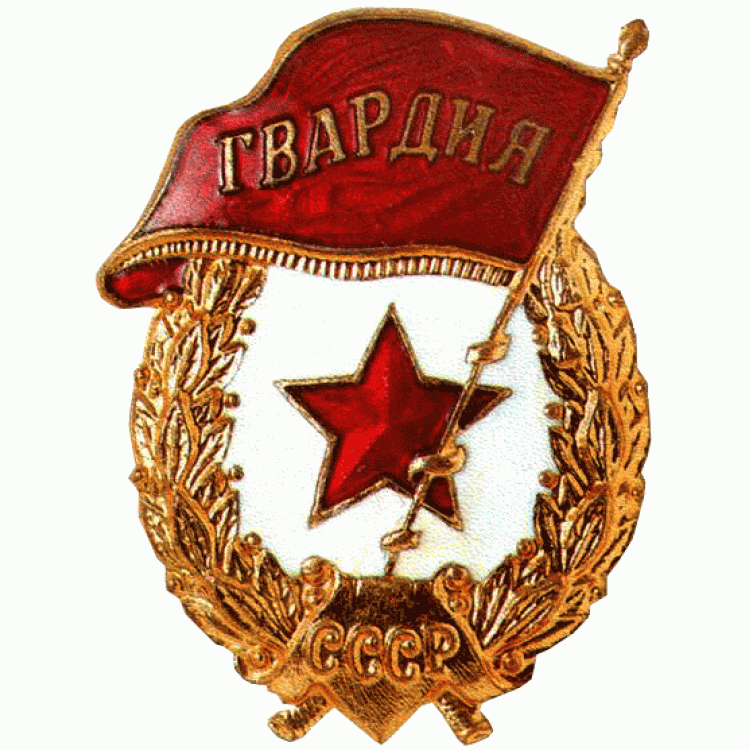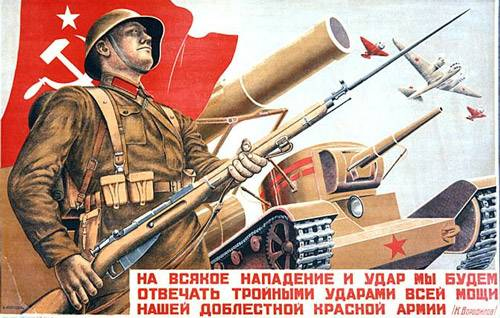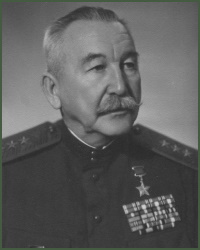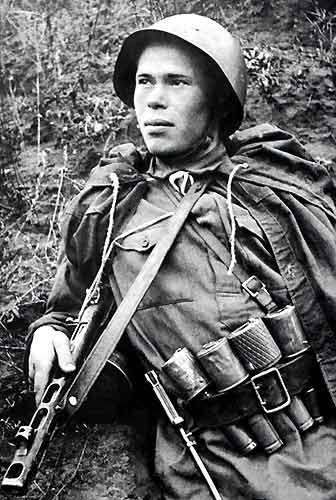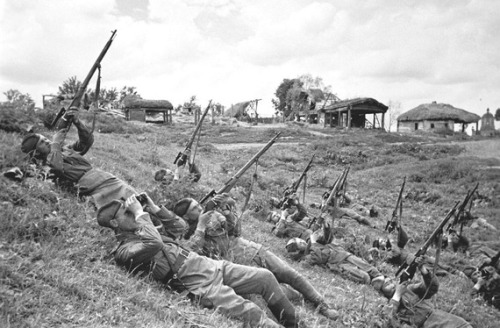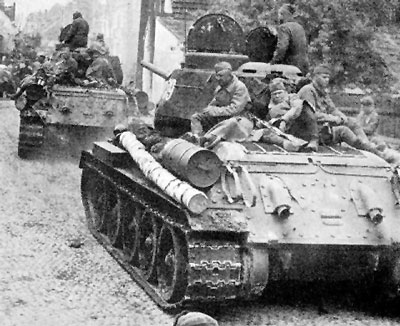Open Day FoW in 20mm Game: Defense of Niedlingen, East Prussia (Winter 1944-45)
The (fictitious) East Prussian Town of Niedlingen is situated a about 600 hundred kilometers east of Berlin, near Arnswalde.
Historical context:
In early February 1945, the 11th SS Panzer Battalion Nordland was ordered onto the offensive as a part of Operation Sonnenwende, the plan to destroy a Soviet salient and to relieve the troops besieged in the town of Arnswalde.
Soon however, strong Soviet counter-attacks halted the division's advance, and Steiner called off the attack, pulling the III (Germanic) SS Panzer Corps back to Stargard and Stettin on the northern Oder River. The 10. SS-Panzer-Division "Frundsberg", led by Brigadeführer Heinz Harmel, also took part in the operation after being detached from the II SS Panzerkorps in December 1944 (at the time engaged on the Western Front).
Flames of War in 20mm
By 21 February the conclusion was arrived-at that no more useful gains could be made against an increasingly powerful enemy without incurring undue casualties, so Steiner ordered a general withdrawal back to the north bank of the river Ihna.
This is where our battle is set.
Elements of the 11th SS Panzer Division Frundsberg occupy the Town of Niedlingen, East Prussia
General Jaydovich advising Colonel Bruce-chev on the best use of the Soviet Guards Army Tankovy
Russian armour arrive on the banks of the frozen Ihna River
German pioneers have laid a mine-field on the north bank. A pedestrian bridge (left) and a
single lane metal bridge span the river. The Germans have not had time to dig in, so swift has the Soviet retaliation and pursuit been.
The fuel dump (Soviet Objective 1) is defended by a Pak 40 and MG 42 along with infantry
Turn one: Colonel Bruce-chev approaches the two bridges, and orders a unit of Cossacks and a unit of Partisans to clear the minefield. As the Don Cossacks had fought on both sides of the war, they are considered expendable, as are the partisans.
Among their number is a group of nuns, possibly secreting hand-weapons under their habits.
Several groups of partisans succumb to the mine-field. Somehow the nuns survive, and keep moving forward. The Cossacks follow eagerly behind them on horseback.
The second Soviet objective is the town centre of Niedlingen. The only road approach is protected by two stugs and several Pak 40s. The town centre is held by a number of Panther tanks. In the fields beyond the town is a unit of Nebelwerfers and an artillery battery of 7 LeFH 18 howitzers.
Her Oberst is ably assisted by Herr Leutnant Romlet in his first battle. Fresh out of Panzer schule he is very knowledgable on armour and eager for battle.
The Soviets attack first, and drive for the bridges
IS-2s clearing a bank on their race for the bridge
Columns of Soviet Armour pouring towards Niedlingen
The German 1st turn sees the lead T34-85 and T34 Obr 1943 destroyed on the bridge. The Soviets are caught in a bottle-neck. They try to cross the frozen river on foot, but the infantry commander falls through the ice on a roll of a 1. (Roll anything but a one, Bruce!)
PTRDs move up to give defensive fire while the heavy IS-2s advance
The Nebelwerfers and LeFH18s take a heavy toll on infantry, mortar units and 122mm Howitzers, almost all falling prey to the template of mass destruction
Turn 2 degenerates on both sides into an artillery slugfest, with almost all infantry in range being destroyed by artillery fire. Su76s, 85s and IS-2s all unleash a torrent of lead on the German defenders. Pak 40s, mortar units, MG crews, all fall to the murderous fire.
The Germans return the favour with all their artillery capable of firing HE and rockets.
The Soviets used foresight, and brought a recovery vehicle with them. The burning T34s are swiftly moved out of the way, and IS2s and ISU 122s start crossing the bridge

Turn Three: CCCP: The Cossacks and Partisans advance through and clear the mine-fields.
Seems some of the German soldiers are good catholic boys,
and cannot get themselves to shoot at the nuns.
They make it to the fuel storage tanks, habits flowing in the mid-winter wind.
The Cossacks cavalry charge the defenders, mowing them down with SMG fire. The last men standing are two artillery observers. They fall to merciless flashing sabres and flailing hooves in the assault phase. The nuns and the cossacks take the objective
Their Turn 3 sees the Germans leave the town centre, in an attempt to outflank the Cossacks attacking the fuel dump.
StugGs, Panthers and Jagdpanthers advance past the church. Reinforcements arrive, but fail to make any impact on the rest of the battle.
German armour rushing towards the Russian advance
Turn 4: The Soviets counter with armour to back up the Cossacks holding the fuel dump.
The T34s make it across the frozen river, but for some reason the assault gun commanders seem to think that their vehicles weigh the same as the medium tanks.
The lead SU 85 plunges to the bottom of the frozen river, with only a small splash and trail of bubbles to mark his passing. The rest stall on the bank.
Desperate to remove the nuns and cossacks from the fuel dump the SS bring up their heavy hitters.
A King Tiger and Jagd Tiger with an Begleit Panther clank through the narrow streets. The bulk of the factory and station prevent them from drawing a bead on the cavalry troops. They are unable to shoot.
Unfortunately for them, they are now within the range of the tankbusters.
The Panther is the first to brew up in Turn 5
During their turn 4 the Germans also bring up the balance of their Panthers
and two tank destroyers of their own
Turn 5: The sole surviving PTRD fires from the farmyard
Hits the flank of the lead StuG who had not thought to wear schurtzen that day.
This oversight creates a fatal bottle-neck for the German tanks
The assault guns continue to rain destruction, and this time it is the King Tiger that cops it.
It is hard to stop a barrage of 122 mm shells dropping on your thin top armour
Source of the destruction: ISU 122s and IS-2s en masse, protected by SU 76s and T34-85s
Final moments of the 10. SS Tank Battalion at Niedlingen.
The tightly packed German armour succumb to a whirlwind of Russian shells. The nuns and Cossacks hold an objective by the end of the game, and the Germans fail in their attempt to deny the Russians and push them back across the river.
A resounding victory to Colonel Bruce-chev and his Red Guard Tankovy
